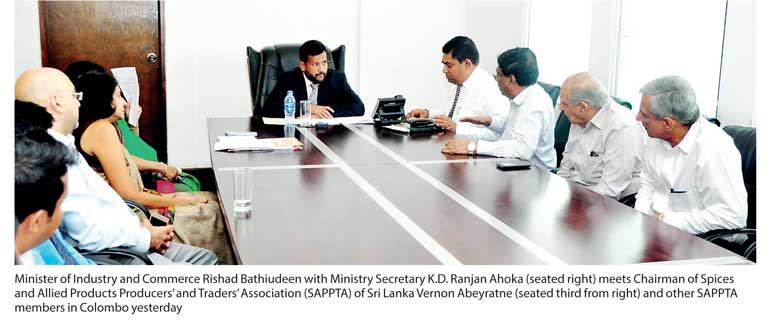Tuesday Apr 22, 2025
Tuesday Apr 22, 2025
Friday, 26 January 2018 00:00 - - {{hitsCtrl.values.hits}}

A breakthrough in the Ceylon Black Pepper gridlock came yesterday as Sri Lanka suddenly abolished its long-practiced slow export clearance timeline on its reputed King of Spices, along with an announcement that the Commerce Minister is planning to visit New Delhi to resolve incompatibilities on the reception of Ceylon Black Pepper in the Indian market.
“This pilot initiative is to strengthen the reputation of Ceylon Black Pepper as well as to support our committed spice exporters,” said Industry and Commerce Minister Rishad Bathiudeen yesterday in Colombo.
Minister Bathiudeen, joined by his top officials, was meeting members of the Spices and Allied Products Producers’ and Traders’ Association (SAPPTA) of Sri Lanka who revealed the latest situation to him on their black pepper sourcing and exports. Member firms of SAPPTA handle exports of no less than 30 spice product lines.
In 2016, Sri Lanka’s spice exports totalled $ 264 million and black pepper exports were at $ 72 million (declining from 2015’s $ 144 million). International demand for Lankan pepper cannot be satisfied easily and as a result domestic production has also increased with the support of the Government. The total production of 17,000 MT of black pepper in Sri Lanka in 2012 surged to 18,660 MT in 2014 and has peaked to 25,995 MT by last year (2017). Annual local household consumption ranges from 5,800 MT to 6,000 MT and in 2016, the industrial consumption was at 5,312 MT. In 2012, for the first time Ceylon pepper overtook Ceylon cloves to become the second largest spice export of Sri Lanka, the leading spice export being Ceylon Cinnamon.
SAPPTA members voiced that the black pepper flowing in the direction of Sri Lanka from other foreign sources have greatly impacted the reputation of Ceylon Black Pepper. “We call for your immediate attention on foreign peppers being mixed to Sri Lankan peppers, which is of higher quality,” said SAPPTA Chairman Vernon Abeyratne, adding: “Pepper exports of some Lankan companies such as my firm are of EU Standards. Such mixing of foreign pepper is possible at a different stage of shipping and out of our control, and as a result we passed a resolution calling for the ban of foreign pepper coming to Sri Lanka or impose a licensing for such inferior imports to ensure low-quality, pesticide-ridden stocks do not land here. The slow pre-shipment process of our domestic pepper exports is an additional issue that prevents our competitiveness on such inferior quality transshipments. The Indian authorities have imposed a Minimum Import Price for pepper imports to protect their growers due to inferior pepper leaving from countries such as Sri Lanka which is beyond our control.”
Black pepper produced in Sri Lanka has no pesticides and is organically grown, and has a larger piperine content – a substance greatly used for medicinal, dietary and flavouring applications. Therefore Sri Lanka finds that international demand for Lankan pepper cannot be satisfied easily.
“As Sri Lanka’s premier global trade agency to boost exports, the Department of Commerce (DoC) is performing commendable acts,” said Minister Bathiudeen.
“To strengthen DoC’s capacity to conduct investigations prior to the issuance of black pepper Certificates of Origin (CoO), I am enlisting, with immediate effect, the Consumer Affairs Authority under my ministry and its 400 investigation officers with the DoC. CAA will handle the quality inspection of black pepper packed for export. With immediate effect I also order DoC to process black pepper export applications within 48 hours instead of one to two weeks as done at present. All pepper exporters should submit their export licence to DoC with their application so that we can assure organic, the high quality of our pepper to global markets. DoC is hereby instructed to inform CAA within 24 hours of receiving each pepper export application so that inspections are promptly completed on location. I am planning to lead a Lankan spice delegation to India next month to resolve any pending pepper and spice export issues and optimistic of a positive outcome. I invite members of you SAPPTA to join me. Pepper exports to India are taking place under the South Asian Free Trade Area (SAFTA) and we thank the Government of India for allocating this facility to us where we need to pay only 8% import tariff, and zero duty under pepper exported through the Indo-Sri Lanka Free Trade Agreement at that end, due to our high quality. Indian consideration to us is a great support for our pepper sector.”
SAPPTA members who met Minister Bathiudeen thanked him and added their members shall now “keenly look forward to join Minister Bathiudeen’s visit to New Delhi.”
Around 60% of annual Lankan black pepper exports are headed to India - the rest to other destinations such as the EU and the US. Last year an estimated 8,700 MT of Ceylon Black Pepper was exported to India under SAFTA. International news reports this January said that the Indian Ministry of Commerce and Industry has approved the proposal of the Indian Spices Board for fixing the CIF value of Indian Rs. 500.00 per kg as the Minimum Import Price for pepper to protect the interests of the country’s local pepper growers. In 2016, the leading Lankan spice export to the world was Ceylon Cinnamon at $ 159 million, followed by Ceylon Black Pepper $ 72 million, cloves $ 13 million, nutmeg $ 13 million and cardamom $ 6 million.